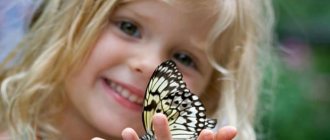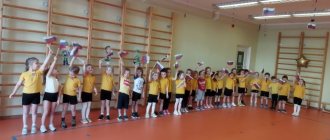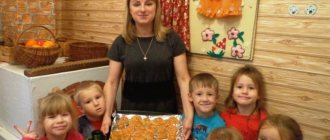Lesson summary “Hello, summer!” in the middle group
Summary of the GCD “Hello, summer!”
for children in the middle group of kindergarten Goal: generalize and expand children’s knowledge on the topic “Summer”. Objectives: Educational:
- consolidate knowledge about seasonal changes in nature, in the summer, about insects, their structure, habitats, about wild berries and mushrooms;
— consolidate the ability to solve riddles, classify clothes by season, form adjectives from nouns, and independently evaluate your knowledge. Educational:
- cultivate a caring attitude and love for nature;
- cultivate environmental awareness. Developmental:
- develop communication skills;
improve gross motor skills and coordination of movements; - develop emotional responsiveness. Types of children's activities: cognitive - research, communication, play, perception of fiction, musical perception. Materials and equipment: a mat - a clearing with flowers and insects, a caterpillar, threads for a cocoon, a butterfly in a cocoon, a spider, counting sticks, a poster with drawings of clothes, summer hats, flowers and butterflies according to the number of children, thematic pictures.
Progress of GCD
Organizational moment. (The teacher has the sun in his hands) Educator: Guys, look, the sun has come to visit us. We enjoy the sun at all times of the year. What time of year is it now? (summer)
.
Educator: What other seasons do you know? (Children's answers)
.
Statement of the problem Educator: Guys, we have already talked about summer. To feel comfortable in the summer, you need to choose the appropriate clothes. Didactic game “Summer Clothes” Purpose:
to show children’s ability to classify clothes by season.
Educator: So, summer clothes have been chosen. I invite you to the summer meadow. Come up, put on caps, panama hats, hats... (children put on hats)
.
Educator: Tell me, why did we put on hats? (children's answers)
.
The teacher praises the children for the correct answer and invites
them to play a game : “Summer, summer, summer - what color is it?
Come on, tell me, come on, show me. Gently green, like a grasshopper in the grass (they jump like grasshoppers)
, Yellow, yellow, like sand near rivers
(show sand and a river wave)
, Bright, blue, the most beautiful
(raise their hands up, spin around themselves)
, This is what summer ..
(Calm music sounds, children approach the prepared clearing and sit around)
.
Children look at flowers, recognize and name them. The teacher praises the children for correct answers, shows soft green grass and asks: “Who can live here without being noticed?” If the guys have difficulty answering, it suggests that these residents are very small, very tiny. Summarizing the children's reasoning, the teacher says that insects are extraordinary animals, they can hide in the grass so that no one will notice them; wondering what insects children know? (Fly, bee, mosquito, ant, dragonfly, wasp, etc.) Educator: I will tell you riddles about insects, and you will guess them and find this insect in the clearing. The black toddler pulls a load that is not tall enough for him. (Ant.) The teacher reads
a poem : An ant cannot be lazy, an ant lives by work.
Everything he sees is dragged into his underground home. Educator: Ants, like bees, are great workers. I suggest you guys turn into little ant brothers. Game “Ants Build a House” Goal:
development of motor activity.
Children line up in two columns. Everyone must move the counting stick to the table and build an anthill. That cow does not moo, has no horns, hooves, tail, does not give us milk, lives under the leaves. This one deftly fights harmful aphids... (ladybug.)
All four petals of the flower moved, I wanted to pick it, It fluttered and flew away.
(Butterfly.)
She is bright, beautiful, graceful, light-winged.
She looks like a flower and loves to drink flower juice. (Butterfly)
.
I took the name from a blacksmith, the color from a cucumber, the wings from a cloudberry, the legs from a flea. (Grasshopper.)
What kind of girl: She wears a thin belt, Huge eyes, Flies and chirps.
(Dragonfly.)
She is a generous housewife;
Flies over the lawn, fusses over the flower and shares the honey. (Bee.)
The teacher reminds the children what bees eat as they fly from flower to flower and encourages correct answers.
Explains that a bee produces honey from nectar; reinforces the already known word “hardworking”, since these insects love to work; clarifies children's knowledge about the bee house; tells the kids that there are many bees living in the hive. Low mobility game “Helpers” Educator: Imagine that the clearing has run out of nectar, the teacher invites the children to imagine, and a scout bee flew out of the hive to scout, buzzed, flew far, far away, found a clearing, but she couldn’t carry so much nectar alone. , and the bee called her friends, raise your right hand, kids, the teacher offers to play, get your index finger ready, fly to find out how many bees we have, the bees are buzzing loudly, they have flown far away, their voice is barely audible (the kids are buzzing loudly, quietly, running around the hall , with the index finger of the right hand imitating the movements of a bee)
.
The bees sat on a flower, collected nectar and flew home. The teacher carefully places the bee back on the flower, accidentally touching the large green leaves, lifts them, showing the insect hidden under it, and asks the children in surprise who it is? (answers)
.
The teacher carefully removes the caterpillar and shows it to the children, reminding them to be careful with tiny insects; asks the guys if they like fairy tales; offers to tell a fairy tale about a caterpillar . A fairy tale about a caterpillar “Once upon a time there was a caterpillar (the teacher shows a toy, strokes it)
, who considered herself very pretty, but those around her did not like her at all, and everyone who met her said: “Ugh, what an ugly, ugly caterpillar.”
And she began to hide from everyone under the leaves. One day the caterpillar became completely sad and, out of resentment, cobwebs came out of her mouth, like tears. She began to wrap herself in it, wrapped herself, wrapped herself (the teacher shows the children how the caterpillar wrapped itself and invites them to play with it, repeat the movements)
and turned into a cocoon
(the teacher takes out a cocoon from under another sheet and shows it to the children)
.
She felt calm and warm in the cocoon. The caterpillar stuck to a leaf and fell asleep, and when she woke up, she felt that she felt very cramped in the cocoon. She tried to roll over, but something was stopping her, and the caterpillar realized that she now had wings. She straightened them, and the cocoon burst, and a butterfly appeared from the cocoon, she was very beautiful, and everyone who called her scary and ugly began to admire: “Oh, what a beautiful butterfly.” And the butterfly fluttered from flower to flower, and only smiled back at them. After waiting a short pause, the teacher asks whether the children liked the fairy tale, what happened to the caterpillar, and invites them to rejoice at this transformation together with the butterfly and fly a little.
“Wings flicker in the field, Butterflies fly in the field, They fly, they spin, They stop on a flower.”
(Performing movements according to meaning)
.
Educator: These are the insects that live in the summer meadow. Now let’s complete the tasks that the sun has prepared for us. Completing tasks about insects. Didactic game “Who lives where?” Goal: to consolidate knowledge about the places where insects live. (On the screen there is a picture with insect houses)
.
You need to name the “house” and say what kind of insect lives there.
And then this insect will fly into its home. (Children name houses and insects, and the corresponding insect appears on the screen)
.
Didactic game “Who is the odd one out here?” Goal:
to consolidate knowledge about the distinctive features of insects.
(On the screen there are insects and among them a spider)
.
Educator: Guys, look carefully at the pictures and determine which picture is the odd one out here and tell me why? (Children find an extra picture with a spider and explain that insects have three body parts: head, chest, abdomen, insects have six legs, and a spider has more)
.
Educator: What a great fellow you are, you know so much about insects, look at the screen, the sun is smiling at you, which means you completed the tasks correctly. A walk in the summer forest Educator: Do you want to take a walk in the summer forest? Then, go ahead! A green friend is waiting for us to visit, Birch trees, linden trees, maples are waiting, Herbs, berries, mushrooms of unprecedented beauty. Pines, spruces to the sky, Green friend, this is... (forest)
.
Physical education lesson And blueberries grow in the forest, (Squats)
Strawberries, blueberries.
To pick berries, you have to squat lower. I took a walk in the forest, (Walking in place)
I carried a basket of berries.
Educator: What grows in the forest in the summer? (Berries, mushrooms)
.
What berries do you know? Show and name berries you know. (Demonstration of pictures with wild berries: strawberries, raspberries, blueberries, cranberries, currants, gooseberries)
.
Word game “Which one?” Which?" Goal:
strengthening the ability to form adjectives from nouns.
Strawberry juice (what?)
– strawberry.
Blueberry jam (what kind?)
– blueberry.
Raspberry compote (which one?)
– raspberry.
Currant jam (what kind?)
– currant jam.
Educator: Great, you also know a lot about berries! The sun is smiling at you again. (Picture “The sun is smiling”)
.
The berries have been picked, but what else can you pick in the forest in the summer? (Mushrooms)
.
Didactic game “Check the mushroom picker’s basket” Goal:
to consolidate the ability to distinguish seemingly poisonous mushrooms: fly agaric and toadstool.
(Picture “Hedgehog with a basket of mushrooms”) Educator: Guys, the hedgehog picked mushrooms and doesn’t know if they are all edible. Let's help him sort out the mushrooms. (Pictures of edible and inedible mushrooms)
.
Children find inedible mushrooms
(fly agaric and toadstool)
and name them.
Conversation “What can happen if you eat a poisonous mushroom?” (Children's answers)
.
Well done guys, you also know a lot about mushrooms. Summer appears. Summer: How did you end up here? And why did they come here? (Children's answers.)
- What good kids!
I don’t feel sorry for anything for such good kids! I brought you gifts - no one else has those. (Summer gives the children a basket of fruit.)
Our journey is over.
Reflection Educator: - What did we talk about today? (Children's answers)
.
- To make the summer bright, you and I will plant butterflies in this flower meadow. (Prepare a panel with flowers in advance according to the number of children)
. “Everyone in turn will take a butterfly, and before planting it on a flower, they will say what they liked best.”
We recommend watching:
Scenario for summer fun in the middle group Scenario for summer fun for Children's Day in kindergarten Methodological development of a scenario for summer fun for children in the middle group Final lesson for the middle group on the topic: Summer
Similar articles:
Scenarios for summer holidays and entertainment in kindergarten. Middle group



